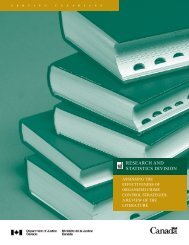National Threat Assessment 2008. Organised Crime - Politie
National Threat Assessment 2008. Organised Crime - Politie
National Threat Assessment 2008. Organised Crime - Politie
You also want an ePaper? Increase the reach of your titles
YUMPU automatically turns print PDFs into web optimized ePapers that Google loves.
Mainly native Dutch offender groups are involved in cargo theft; almost<br />
all perpetrators are men. This pattern is confirmed by many sources, as well<br />
as the regular involvement of criminals from trailer park circles.<br />
A further notable characteristic of offenders is that in almost all investigations<br />
a suspect was identified who knew his way around in the transport sector. Most<br />
of them were drivers. This confirms the idea that cargo theft is an offence that<br />
requires a certain level of expertise. Many suspects have criminal records. Apart<br />
from criminal records for theft and handling stolen goods, over half of them also<br />
have criminal records for violent crimes and traffic offences. Many of the thieves<br />
in particular have a history of violence, which is surprising because cargo theft<br />
hardly ever involves violence.<br />
The degree of organisation of cargo theft varies. Sometimes the groups are<br />
more or less permanent and sometimes the collaboration is temporary. The level<br />
of professionalism of the groups is shown by their working method; they often<br />
steal to order. The groups have contacts in the sector and are sufficiently<br />
organised to fulfil these orders. The binding factor in a number of groups is their<br />
common caravan camp background. In some cases these are family ties; in other<br />
cases the members have a common country of origin. In general there is a set<br />
division of duties among the members.<br />
4.4.5 Consequences for Dutch society<br />
The consequences of cargo theft for Dutch society are diverse and include not<br />
only the direct financial loss as a result of the theft, but also indirect damage as<br />
a result of absence due to illness, missing out on orders, damage to the vehicles<br />
and loss of reputation. Some of these consequences can be expressed in terms<br />
of money, but this is a lot more difficult for other consequences.<br />
Various estimates of the financial loss are available and the amounts vary widely.<br />
The Dutch Transport Operators Association (TLN) estimates the loss incurred<br />
through lorry and cargo theft as at least 150 million euros per year. The<br />
Foundation for Tackling Vehicle <strong>Crime</strong> estimates 360 million. The insurance<br />
company TVM has calculated 400 to 600 million euros. In the Business<br />
Community <strong>Crime</strong> Monitor, which is periodically drawn up by WODC, the loss<br />
incurred by the transport sector in 2005 as a result of theft and burglaries is<br />
estimated at € 43 million. This reflects the direct damage; indirect damage in<br />
the form of consequential damage, liability, preventive measures, is not included<br />
in these amounts. As a result, these amounts can best be described as a lower<br />
limit. However, whatever the case may be, it is clear that the damage suffered<br />
is considerable.<br />
156 <strong>National</strong> <strong>Threat</strong> <strong>Assessment</strong> 2008 – <strong>Organised</strong> crime








